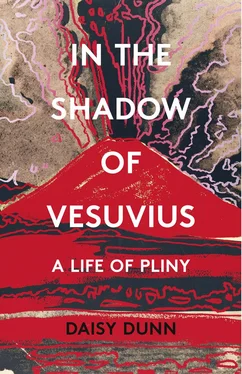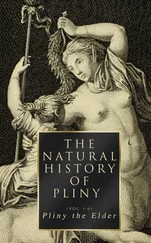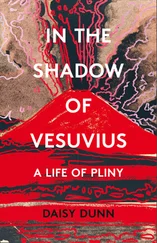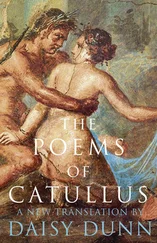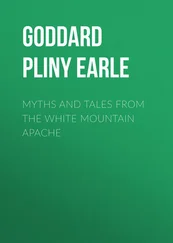1 ...7 8 9 11 12 13 ...18 
Pliny the Elder was not alone in his fascination with natural phenomena. A banker named Lucius Caecilius Iucundus adorned the household shrine of his villa in Pompeii with scenes from the devastating earthquake of AD 63. A temple of Jupiter, Juno and Minerva and an archway to the forum are shown swaying on their foundations.
Hamilton sent observation after observation of the volcanic activity to the Royal Society, of which he was a fellow. His letters later formed the basis for a book. Hamilton’s Campi Phlegraei, on the ‘flaming fields’ of Campania, was illustrated with colour prints by an artist named Pietro Fabris, who captured perfectly the sense of complacence that such a beautiful landmark could inspire in those who lived beneath it. Here was flame-crowned Vesuvius, billowing puffs of smoke into the pale skies of Italy while finely attired ladies looked on casually from across the water.
Hamilton had arrived in time to observe some of the excavations which had begun at Pompeii. It had long been known that cities lay hidden underground. Already in Francis Bacon’s time, an Italian architect had chanced upon the ruins of Pompeii while digging a canal. There is evidence that people had begun tunnelling through the ancient layers of Herculaneum too, as early as the thirteenth or fourteenth century. 21But it was only in the decades before Hamilton arrived, and at the instruction of King Charles III of Spain, that the process of uncovering the cities began in earnest. Excavations were first undertaken by a Spanish military engineer named Rocque Joaquin de Alcubierre in Herculaneum in 1738 and at Pompeii a decade later. As Hamilton noted, the ancient villas of Pompeii were ‘covered about ten or fifteen feet, with pumice and fragments of lava, some of which weigh three pounds’. 22Excavators at both sites made a priority of removing precious objects and wall paintings from the layers. Like the poor and displaced who had returned to the buried cities in the immediate aftermath of the disaster and squeezed into the villas to claim whatever Vesuvius had failed to, the excavators worked more greedily than methodically. Their digs were haphazard, sporadic, and limited in scope, with little thought given to stabilising the structures underground.
Preserved within the snow-like layers were imprints of the victims of the disaster of AD 79. The shapes of human bodies frozen in time were more palpable than fossils, but proved far less easy to extract from the ground. It was only some decades later, in the mid-nineteenth century, that a Neapolitan numismatist and archaeologist named Giuseppe Fiorelli developed a technique for preserving what remained of the ancient dead. Fiorelli was appointed director of excavations at the University of Naples in 1860 following a tumultuous period in his life. Arrested and imprisoned on charges of colluding with revolutionary forces, and deprived of his research notes, he was fortunate to have been released a short time later and made secretary to the Count of Syracuse. 23Following archaeological work at Cumae, he arrived in Pompeii, and was a few years into his new post when he poured plaster into the cavities which the shapes of the dead had left behind in the volcanic deposit. The process enabled whole bodies to be cast in the positive.
Fiorelli went on to make dozens more casts through the same technique. He came as close as anyone could to raising the dead from their undignified tombs and reinstating them among the living. His casts gave each victim an identity. These were not just men, women, children, dogs. Every cowering shoulder and clenched fist represented an individual’s response to the tragedy. Each position captured something of their personality, or at least you imagine that it did; it is easy to forget that each cast is more than a work of art. The flesh had decayed over time but, in his casts, Fiorelli created the illusion of having preserved it forever.
Excavations are still ongoing in the Bay of Naples. Significant parts of Pompeii and Herculaneum are yet to be uncovered, but the process of sifting through the layers has already called into question when precisely in AD 79 Vesuvius erupted. Of all the details Pliny provides in his accounts of the eruption, the date has proven the most contentious. The manuscripts of his letters offer a range of dates, of which 24 August is the most secure textually. 24But while there is evidence in the concretised ash that trees were still in leaf and the broad beans of summer still fresh at the time of the eruption, other signs suggest a later date. 25Among the material remains discovered in the layers are olives, plums, figs and pomegranates, which are harvested principally in September and October. 26Braziers were positioned in such a way as to heat rooms in some of the villas. Summer clothes had made way for the warmer coverings of winter. 27Was Pliny mistaken over the date, or were these the fruits of another harvest, the preparations for an unseasonably cold August, the heaviest fabrics the victims could find to protect their skin from burning pumice?
The object most commonly cited in support of a post-August date is a single coin from a hoard discovered in the ‘House of the Golden Bracelet’ in Pompeii, where two adults and two children were also preserved in their final tragic moments. So embedded in the volcanic layers that it could not simply have been dropped at the site after the eruption, the coin features an inscription that led scholars to date it to post early September AD 79. The coin, however, is very poorly preserved, and a recent re-examination has revealed that its legend was misread by the original interpreter. The coin has now been dated to July or August AD 79. 28The strongest evidence today for a later eruption date is the fact that the volcanic matter was dispersed in a south-easterly direction; the winds in the Bay of Naples seldom blow south-east in August. 29
It is entirely possible that the scribes made an error in copying the manuscripts and that 24 August was not the date Pliny originally recorded. 30Of all the days the volcano could have erupted, however, this was perhaps the most dramatic. In the Roman calendar, 24 August was the day after the Vulcanalia, an annual autumn festival during which worshippers constructed towering bonfires in honour of the fire god and tossed fish from the Tiber raw into its flames. Fire and water: give Vulcan what was ordinarily out of his grasp, and he might be persuaded to spare the crops for harvest season. It was a cruel and insatiable god who fanned the flames of Vesuvius just a day after receiving his feast of fish.
We may never know whether Pliny was mistaken over the date of the eruption or, more likely, there was an error in the transcription of his letters. The merest possibility that Pliny might have been wrong is surprising because he was by nature extremely meticulous. His was a logical rather than a creative mind: attuned to detail and hard fact, obedient to protocol. Where his uncle was creative, Pliny was pedantic. You can tell from his prose how much care he took in finding the right phrase to express himself. Whereas Pliny the Elder was economical with his words but prone to write in sentences which changed direction with his every thought, Pliny favoured a more methodical and measured style, which reflected his occupation and approach to life more generally.
Less than a year after the eruption, at the age of eighteen, Pliny embarked upon a career as a lawyer in the Centumviral Court. 31The centre for civil cases, the court was based within the Basilica Iulia, a beautiful multi-storeyed building in the Forum Romanum. Although it was eclipsed in Republican times by other courts, the Centumviral was now considered one of the most important in Rome. 32Its work was highly technical and required Pliny to examine disputes arising over wills and inheritance and tackle cases of extortion and fraud. Though nominally a ‘Court of One Hundred Men’, who were arranged over four tribunals, the number of jurors often by now reached 180, and there was plenty of space besides for spectators.
Читать дальше
